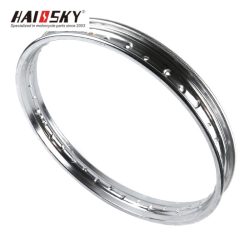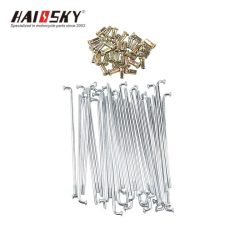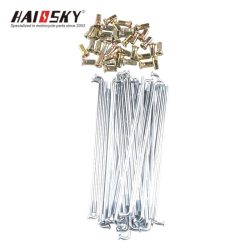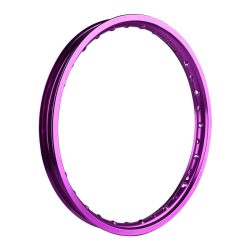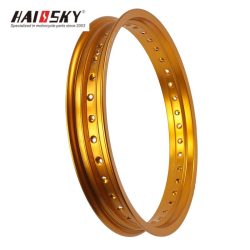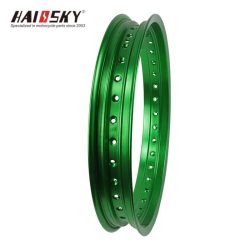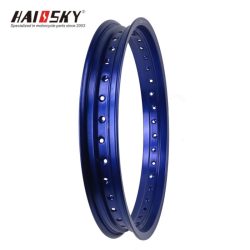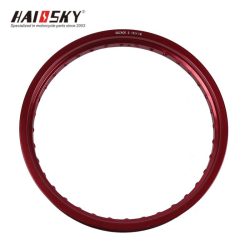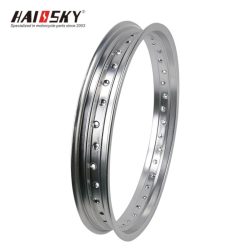OEM Motorcycle Parts
Category: Motorcycle Rims - Spoke & Alloy Options
Everything You Need to Know About Motorcycle Rims
When it comes to motorcycle performance, safety, and aesthetics, the motorcycle rim plays a pivotal role. As the foundation of the wheel, the rim supports the tire and ensures smooth handling, stability, and control. At Haissky.com, we specialize in providing high-quality motorcycle rims to B2B wholesalers and riders. In this guide, we’ll explore the types of motorcycle rims, their specifications, maintenance tips, and how to choose the right rim for your bike. We’ll also answer some frequently asked questions to help you make informed decisions.
What Are Motorcycle Rims?
A motorcycle rim is the outer edge of the wheel that holds the tire in place. It is a critical component that affects the bike’s handling, acceleration, braking, and overall performance. Rims come in various sizes, materials, and designs to suit different motorcycles and riding styles.
Types of Motorcycle Rims
Motorcycle rims are designed to meet specific needs, whether for off-road adventures, high-speed racing, or everyday commuting. Here are the most common types:
1. Spoke Rims
Spoke rims are the most traditional type, commonly found on off-road and cruiser motorcycles. They consist of a central hub connected to the rim by thin metal rods called spokes.
Pros: Lightweight, durable, easy to repair, and versatile.
Cons: Require regular maintenance and are less aerodynamic.
2. Cast Rims
Cast rims are made from metals like aluminum or magnesium through a casting process. They have a solid, smooth surface and are popular on street and sport motorcycles.
Pros: Low maintenance, sleek design, and excellent high-speed stability.
Cons: Difficult to repair if damaged and heavier than other types.
3. Carbon Fiber Rims
Carbon fiber rims are a high-tech option for modern motorcycles. Made from carbon fibers, they are incredibly strong, lightweight, and durable.
Pros: Improve performance by reducing weight and enhancing balance.
Cons: Expensive and less common for everyday use.
Specifications and Maintenance of Motorcycle Rims
Proper maintenance ensures the longevity and performance of your motorcycle rims. Here are some key tips:
1. Visual Inspection
Regularly inspect the rims for cracks, dents, or deformations. For spoke rims, check for loose or broken spokes.
2. Pressure Check
Ensure the tires are inflated to the manufacturer’s recommended pressure. Underinflation or overinflation can lead to uneven wear and poor handling.
3. Cleaning and Lubrication
Clean the rims regularly using mild soap and water. Avoid harsh chemicals that can damage protective coatings. Lubricate moving parts like wheel bearings and spoke nipples (for spoke rims).
4. Alignment and Balancing
Check for proper wheel alignment and balancing to prevent vibrations and premature wear.
5. Tire Condition
Inspect tires for cuts, punctures, or uneven tread wear. Replace damaged tires promptly to maintain optimal performance.
6. Load and Speed Limits
Adhere to the manufacturer’s load and speed limits to avoid straining the rims and other components.
7. Professional Inspection
After a crash or significant impact, have the rims professionally inspected, even if no visible damage is apparent.
How to Choose the Right Motorcycle Rim
Selecting the right rim depends on your motorcycle type, riding style, and performance needs. Here are some factors to consider:
1. Read the Owner’s Manual
The manual provides essential information about the recommended rim size, type, and load capacity for your bike.
2. Consider Your Riding Style
Street Riding: Opt for lightweight cast rims for better handling and stability.
Off-Road Riding: Choose durable spoke rims that can withstand rough terrain.
Racing: Invest in carbon fiber rims for maximum performance and speed.
3. Evaluate Material Options
Aluminum: Lightweight and affordable, ideal for everyday use.
Magnesium: Stronger and lighter than aluminum but more expensive.
Carbon Fiber: The lightest and strongest option, best for racing.
4. Understand Rim Size
Larger rims provide better grip and stability, while smaller rims offer agility and easier handling.
5. Consider Aesthetics
Choose a rim design and color that complements your motorcycle’s style.
How to Replace a Motorcycle Rim
Replacing a motorcycle rim can be a challenging task, but with the right tools and basic mechanical skills, it’s achievable. Here’s a step-by-step guide:
Tools Needed:
New wheel rim
Spokes and nipples (if re-spoking the wheel)
Wheel truing stand (optional)
Torque wrench
Wheel bearing grease
Wheel bearings (if replacing)
Socket set
Rim tape
Spoke wrench
Tire levers
New tire
Tire pressure gauge
Steps:
Prepare the Motorcycle: Place the bike on a stable, level surface using a paddock stand or center stand.
Remove the Wheel: Loosen the axle nut and wheel bolts. Detach the brake caliper and brake disc, then slide the wheel out.
Dismantle the Wheel: Deflate the tire, remove it using tire levers, and take out the tube.
Remove the Wheel Bearings: Use a bearing puller or socket to remove the bearings from the rim.
Install the New Rim: Clean the new rim, apply grease to the bearing seats, and press in the new bearings.
Reassemble the Wheel: Install the new rim, spokes, and nipples (if re-spoking). Mount the new tire and inflate it to the recommended pressure.
Reinstall the Wheel: Slide the wheel back onto the motorcycle, tighten the axle nut and bolts, and reattach the brake disc and caliper.
Frequently Asked Questions
Q1: What are the rims on a motorcycle?
The rims are the outer edges of the wheel that hold the tire in place. They are crucial for handling, stability, and performance.
Q2: Are mags and rims the same?
Yes, “mags” is a colloquial term for magnesium rims, which are a type of motorcycle rim.
Q3: Will a car tire fit on a motorcycle rim?
No, car tires are not designed to fit motorcycle rims due to differences in size, shape, and performance requirements.
Q4: What is the rim of a bike tire?
The rim is the part of the wheel that holds the tire in place and supports the bike’s weight.
Q5: Can I put any rim on my motorcycle?
No, rims must be compatible with your motorcycle’s make, model, and specifications. Always refer to the owner’s manual for guidance.
Q6: Which is better, rim or mags?
It depends on your needs. Magnesium rims (mags) are lighter and stronger but more expensive. Aluminum rims are affordable and durable, making them a popular choice for everyday use.
Conclusion
Motorcycle rims are a critical component that directly impacts your bike’s performance, safety, and aesthetics. Whether you’re a B2B wholesaler or a rider, choosing the right rim is essential for optimal functionality and style.
At Haissky.com, we offer a wide range of high-quality motorcycle rims designed to meet the needs of every rider. Explore our collection today and find the perfect rims for your inventory or personal use!


